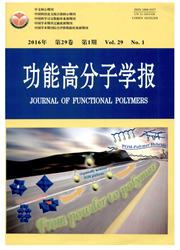

 中文摘要:
中文摘要:
采用分散聚合法,在玻璃基体表面原位生长聚苯胺制得高电导率(10^-3S/cm)、微纳米级的聚苯胺薄膜。通过扫描电镜、原子力显微镜以及接触角分析研究聚苯胺在玻璃基体表面成膜的驱动力和过程。结果表明:成膜的驱动力是聚合过程中产生的活性中间体与基体间的强吸附力。活性中间体主要是苯胺的二聚体、三聚体等短链小分子,它们与基体间的作用为分子间力作用,属物理吸附。聚苯胺在玻璃基体表面成膜的过程符合吸附生长模式,膜的厚度存在饱和值。
 英文摘要:
英文摘要:
Polyaniline (PANI) films with high conductivitities (10^-3 S/cm) and micro/nano-sized thicknesses were prepared through an in-situ growth on glass matrix in dispersion polymerization. The driving force and process of PANI film forming on glass matrix were studied by SEM, AFM observation and contact angle analysis. It is indicated that the driving force is the strong adsorbability of reactive intermediates generated in the reaction. This reactive intermediate is mainly composed of moleculars with short chain such as aniline dimer, trimer, and so on. The action between glass matrix and reactive intermediates is intermolecular force attributed to a kind physical adsorption. PANI' film process on glass matrix accords with adsorption growth model. The thickness of PANI film also has a saturation value.
 同期刊论文项目
同期刊论文项目
 同项目期刊论文
同项目期刊论文
 期刊信息
期刊信息
